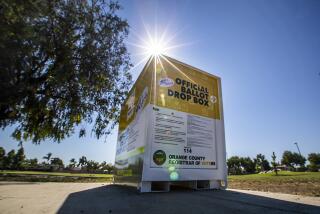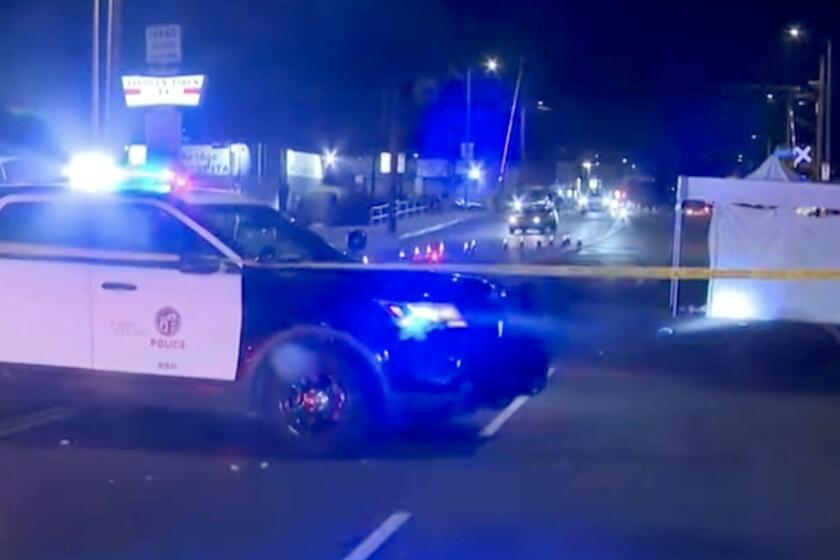When California and L.A. County don’t vote, the nation feels it
The nation tumbled to a new low for voting in November, the lowest since 1942, when many had a rather compelling excuse for not showing up at the polls: World War II.
And it’s on us. On California, that is. Or more precisely, on Los Angeles County.
As voting results became official this week, the stats looked bleak: Just a little more than 42% of California’s registered voters cast ballots in November.
It was bleaker still when you consider those who actually could have voted had they been both registered and compelled to turn out: Only about 31% of all eligible Californians voted, according to the United States Election Project, run by University of Florida political scientist Michael McDonald.
Then there is Los Angeles County, a world apart even from its California brethren. According to the county elections office, 31% of registered voters cast ballots in November, 11 points below the state’s overall turnout. Don’t even consider what the percentage of eligible county voters would have been (in the low 20s, at best).
Other states managed to fly past California by McDonald’s accounting: To California’s 31% turnout of those eligible, Colorado had almost 55%; Alaska, 54% and change; Maine, more than 58%. Only a handful of states had worse showings than California’s.
The state’s outsized impact stems from its size; with 17.8 million registered voters it dwarfs every other state, so it can easily toss sand in the nation’s gears.
Perhaps the upside of embarrassment is talk of solutions. In the city of Los Angeles, officials briefly considered offering a cash bounty to entice voters. (Turnout in the 2013 mayoral elections was a whopping 18.5%.)
The idea was shouted down, at least temporarily, but the complicated nature of nonvoting raises questions of how useful a tactic it would have been. Because it’s not just about people who are too lazy to show up absent some recompense.
What makes people not vote — either to not register, or to register and not vote — is an alchemy of opportunity, culture, excitement and tradition. According to McDonald and other experts, Los Angeles is very nearly the opposite of the kind of place where voters are highly motivated to show up.
The places where people do vote tend to be areas where residents have deep, long-watered roots; where they own homes, attend church, are highly educated and feel guilty if they don’t take part in the exercise, lest their neighbors consider them miscreants.
And then there is Los Angeles, suffused with immigrants, the young, renters, students, people on the move literally and figuratively — those for whom the area is a welcome entry point but not necessarily a life-long or even election-cycle-long residence.
“People who aren’t so tied down don’t see the connection of politics to their lives; they are not so deeply embedded in the political and cultural networks of the areas they have moved to,” McDonald said.
Add to California’s complexity the state’s politics. Sports fans gravitate to big, hard-fought battles rather than blowouts, and the same is true of voters. In November, Californians could have been forgiven for not remembering there was an election.
There were almost no ads — and very little campaigning — for the top statewide jobs. The race for governor was a foregone conclusion; there was no U.S. Senate race. (In 2010, which featured a more competitive governor’s race and a U.S. Senate contest, close to 60% of registered voters cast ballots.) Democrats predictably trounce Republicans in most populated regions.
“The highest profile statewide race was for secretary of state” — the office that runs California elections — noted Dean C. Logan, who bears the unwieldy title of Los Angeles County registrar-recorder/county clerk. “As an election official, that is very exciting.” But, he added, not to voters.
So how to make Los Angeles County more like, say, Sierra County north of Lake Tahoe, where 73% of registered voters cast ballots? (Almost 8 in 10 homes there are occupied by owners, a reality in less than half of Los Angeles County residences.)
Turnout will inevitably rise in the next big election: Voters find presidential contests more exciting; even in Los Angeles County almost 7 in 10 registered voters showed up in 2012.
But cajoling the other 3 in 10 is a far stiffer challenge. Time may help; most voters become more dependable as they age. Some have suggested that mail-in elections, in which all voters receive and mail back ballots, could help; states with that system have seen upticks.
But a ballot mailed out in rootless Los Angeles has no guarantee of hitting its mark. And moreover, Logan noted, the younger voters you’d be aiming at hardly know what stamps are.
“That’s not a model sustainable for future generations,” he said.
Logan said he is heartened that young Californians have shown one measure of civic involvement lately by protesting about immigration and other issues, including police practices. He pins his hopes on designing registration and voting systems that could convince them that casting ballots is the only route to changing what they want changed.
“When they see value in their vote and want to participate,” he said, “we want to grab them right then.”
cathleen.decker@latimes.com
Twitter: @cathleendecker
More to Read
Sign up for Essential California
The most important California stories and recommendations in your inbox every morning.
You may occasionally receive promotional content from the Los Angeles Times.











